In a remarkable breakthrough, Dr. Jin Gu Kang and his team at the Nanophotonics Research Center of the Korea Institute of Science and Technology (KIST) have successfully created a revolutionary radiation-cooling liquid crystal material that not only cools without the need for external power but also emits vibrant colors. This groundbreaking work has been documented in the Chemical Engineering Journal, marking a significant advancement in the realm of cooling technologies.
The Significance of Radiative Cooling
Radiative cooling is a cutting-edge technology that leverages the release of infrared radiation as heat through the atmospheric window to effectively reduce temperatures. This eco-friendly cooling method has garnered attention as a potential alternative to power-intensive air conditioning systems. Traditionally, radiative cooling materials designed for daytime use are white in color to minimize sunlight absorption and deliver optimal cooling performance. However, the limitation of these materials lies in their inability to cater to aesthetic requirements in settings such as buildings or vehicles.
To address this limitation, the quest for colored radiative cooling materials that can achieve both effective cooling and aesthetic appeal has gained momentum. Previous attempts at creating colored radiative cooling materials often fell short, either sacrificing temperature reduction for color production or failing to produce distinct colors in photonic crystals due to light reflection. However, Dr. Kang and his team devised a novel solution by developing bent spiral liquid crystal photonic crystals.
By utilizing a commercial liquid crystal (LC242) and aligning it into a spiral structure through an inducer, the researchers were able to form colored photonic crystals that exhibit vivid colors. Through a spin coating process, these colored radiation-cooling liquid crystal materials were fabricated, offering a visually appealing alternative to traditional cooling materials. When combined with an upper transparent film and a lower metallic thin film, the material demonstrated a remarkable cooling performance, achieving a temperature approximately 30.8°C lower than standard colored paint and 3.1°C lower than ambient air during the day.
The applications of this innovative colored radiation-cooling liquid crystal material are vast and varied. It has the potential to reduce air conditioning consumption in buildings and vehicles where aesthetics play a crucial role. Additionally, it can provide energy-efficient cooling solutions for outdoor leisure items and military tents. Dr. Jin Gu Kang emphasized the simplicity and cost-effectiveness of the fabrication process, highlighting the practicality and efficiency of this remarkable advancement in cooling technology.
The development of the colored radiation-cooling liquid crystal material represents a significant milestone in the realm of cooling technologies, offering a harmonious blend of functionality and aesthetics. With its wide-ranging applications and impressive performance, this innovative material is poised to revolutionize the way we approach cooling solutions in various industries and settings.


Leave a Reply